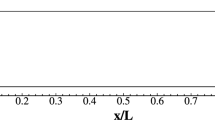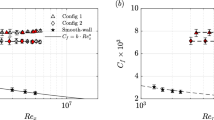Abstract
A numerical study of roughness effects at an actual ship scale is performed. Low-Reynolds number roughness models based on the two-equation turbulence model are employed, meanwhile, a wall function method is also developed. First, the roughness models are examined for the 2D flat plate case at the Reynolds numbers of \(1.0 \times 10^7\), \(1.0 \times 10^8\) and \(1.0\times 10^9.\) The resistance coefficient increases with roughness height and uncertainty analysis of the resistance coefficient is performed. Additionally, the distributions of the non-dimensional velocities \(u^+\) based on the non-dimensional heights \(y^+\) of the low-Reynolds number models and the wall function method are compared for changing the roughness height. Next, the roughness models and wall function method are applied to the flows around a ship at full scale. The tanker hull form with the flow measurement result from an the actual sea test is selected. The propulsive condition with the free surface effect is achieved by the propeller model. The velocity contours are compared with the measured results of the actual ship. The results of the roughness models show good agreement in comparison with the smooth surface condition. The wall function method leads to reduced grid uncertainty with respect to the resistance coefficient and shows agreement with the measured velocity contours. Consequently, the wall function method is better at full scale.












Similar content being viewed by others
References
Kux J, Laudan J (1985) Correlation of wake measurements at model and full scale ship. In: Proceedings of the 15th symposium on naval hydro
Kleinwachter A, Hellwig-Rieck K, Ebert E, Kostbade R, Heinke HJ, Damaschke NA (2015) PIV as a novel full-scale measurement technique in cavitation research. In: Proceedings of 4th international symposium on marine propulsors
Ponkratov D (2016) Proceedings of 2016 workshop on ship scale hydrodynamic computer simulation
Visonneau M, Deng GB, Queutey P (2006) Computation of model and full scale flows around fully-appended ships with an unstructured RANSE solver. In: Proceedings of the 26th symposium on naval hydro
Starke B, Windt J, Raven HC (2006) Validation of viscous flow and wake field predictions for ships at full scale. In: Proceedings of the 26th symposium on naval hydro
Starke B, Drakopulos K, Toxopeus SL, Turnock SR (2017) RANS-based full-scale power predictions for a general cargo vessel, and comparison with sea-trial results. In: Proceedings of international conference on computational methods in marine engineering
Wilcox DC (2006) Turbulence modeling for CFD, 3rd edn. DCW Industries, La Canada
Knopp T, Eisfeld B, Calvo JB (2008) A new extension for \(k- \omega\) models t o account for wall roughness. Int J Heat Fluid Flow. https://doi.org/10.1016/j.ijheatfluidflow.2008.09.009
Apsley D (2007) CFD calculation turbulent flow with arbitrary wall roughness. Flow Turb Combust 78:153–175
Castro AM, Carrica PM, Stern F (2011) Full scale self-propulsion computations using discretized propeller for the KRISO container ship KCS. Comput Fluids 51:35–47. https://doi.org/10.1016/j.compfluid.2011.07.005
Hellsten A (1997) Some improvements in Menter’s \(k-\omega\) SST AIAA-98-2554
Cebeci T, Bradshow P (1977) Momentum transfer in boundary layers. Series in Thermal and Fluids Engineering. Hemisphere Publishing Corporation, Washington
Xing T, Stern F (2010) Factors of safety for Richardson extrapolation. J Fluids Eng 132:6
(1994) Proceedings of of CFD Workshop Tokyo
Ohashi K, Hino T, Kobayashi H, Onodera N, Sakamoto N (2019) Development of a structured overset Navier–Stokes solver including a moving grid with a full multigrid method. J Mar Sci Tech 24(3):884–901. https://doi.org/10.1007/s00773-018-0594-7
Kobayashi H, Kodama Y (2016) Developing spline based overset grid assembling approach and application to unsteady flow around a moving body. J Math Syst Sci 6:339–347. https://doi.org/10.17265/2159-5291/2016.09.001
Eça L, Hoekstra M (2011) Numerical aspects of including wall roughness effects in the SST \(k-\omega\) eddy-viscosity turbulence model. Comp Fluids 40:299–314
Mills A, Hang X (1983) On the skin friction coefficient for a fully rough flat plate. Trans ASME J Fluids Eng 105:364–365
ITTC recommended procedures and Guidelines 7.5-02-03-01.4, 1978 ITTC Performance Prediction Method
Author information
Authors and Affiliations
Corresponding author
Additional information
Publisher's Note
Springer Nature remains neutral with regard to jurisdictional claims in published maps and institutional affiliations.
About this article
Cite this article
Ohashi, K. Numerical study of roughness model effect including low-Reynolds number model and wall function method at actual ship scale. J Mar Sci Technol 26, 24–36 (2021). https://doi.org/10.1007/s00773-020-00718-5
Received:
Accepted:
Published:
Issue Date:
DOI: https://doi.org/10.1007/s00773-020-00718-5




